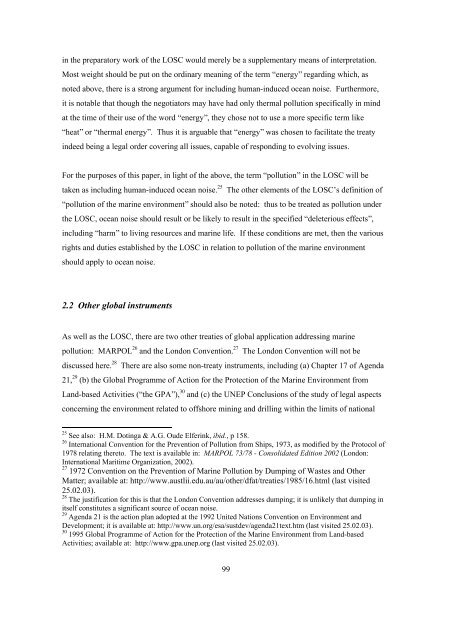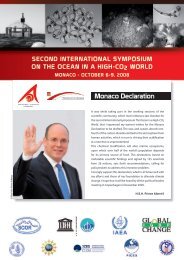in the preparatory work <strong>of</strong> the LOSC would merely be a supplementary means <strong>of</strong> interpretation.Most weight should be put on the ordinary meaning <strong>of</strong> the term “energy” regarding which, asnoted above, there is a strong argument for including human-induced ocean <strong>noise</strong>. Furthermore,it is notable that though the negotiators may have had only thermal pollution specifically in mindat the time <strong>of</strong> their use <strong>of</strong> the word “energy”, they chose not to use a more specific term like“heat” or “thermal energy”. Thus it is arguable that “energy” was chosen to facilitate the treatyindeed being a legal order covering all issues, capable <strong>of</strong> responding to evolving issues.For the purposes <strong>of</strong> this paper, in light <strong>of</strong> the above, the term “pollution” in the LOSC will betaken as including human-induced ocean <strong>noise</strong>. 25 The other elements <strong>of</strong> the LOSC’s definition <strong>of</strong>“pollution <strong>of</strong> the marine environment” should also be noted: thus to be treated as pollution underthe LOSC, ocean <strong>noise</strong> should result or be likely to result in the specified “deleterious effects”,including “harm” to living resources <strong>and</strong> marine life. If these conditions are met, then the variousrights <strong>and</strong> duties established by the LOSC in relation to pollution <strong>of</strong> the marine environmentshould apply to ocean <strong>noise</strong>.2.2 Other global instrumentsAs well as the LOSC, there are two other treaties <strong>of</strong> global application addressing marinepollution: MARPOL 26 <strong>and</strong> the London Convention. 27 The London Convention will not bediscussed here. 28 There are also some non-treaty instruments, including (a) Chapter 17 <strong>of</strong> Agenda21, 29 (b) the Global Programme <strong>of</strong> Action for the Protection <strong>of</strong> the Marine Environment fromL<strong>and</strong>-based Activities (“the GPA”), 30 <strong>and</strong> (c) the UNEP Conclusions <strong>of</strong> the study <strong>of</strong> legal aspectsconcerning the environment related to <strong>of</strong>fshore mining <strong>and</strong> drilling within the limits <strong>of</strong> national25 See also: H.M. Dotinga & A.G. Oude Elferink, ibid., p 158.26 International Convention for the Prevention <strong>of</strong> Pollution from Ships, 1973, as modified by the Protocol <strong>of</strong>1978 relating thereto. The text is available in: MARPOL 73/78 - Consolidated Edition 2002 (London:International Maritime Organization, 2002).27 1972 Convention on the Prevention <strong>of</strong> Marine Pollution by Dumping <strong>of</strong> Wastes <strong>and</strong> OtherMatter; available at: http://www.austlii.edu.au/au/other/dfat/treaties/1985/16.html (last visited25.02.03).28 The justification for this is that the London Convention addresses dumping; it is unlikely that dumping initself constitutes a significant source <strong>of</strong> ocean <strong>noise</strong>.29 Agenda 21 is the action plan adopted at the 1992 United Nations Convention on Environment <strong>and</strong>Development; it is available at: http://www.un.org/esa/sustdev/agenda21text.htm (last visited 25.02.03).30 1995 Global Programme <strong>of</strong> Action for the Protection <strong>of</strong> the Marine Environment from L<strong>and</strong>-basedActivities; available at: http://www.gpa.unep.org (last visited 25.02.03).99
jurisdiction (“the UNEP Conclusions”). 31Chapter 17 <strong>of</strong> Agenda 21Chapter 17 <strong>of</strong> Agenda 21 refers to “pollution” in the context <strong>of</strong> marine environmental protection.However, the focus is on substances <strong>and</strong> effluents, 32 <strong>and</strong> no express reference is made to energyor <strong>noise</strong> or similar terms. Nevertheless, the general references to “pollution” are helpful.GPAThe GPA is a non-binding instrument that deals only with l<strong>and</strong>-based sources <strong>of</strong> environmentaldegradation. The list <strong>of</strong> “contaminants” in the GPA does not include energy or <strong>noise</strong> or similarterms. 33 However, the GPA does identify, inter alia, “military installations”, “coastal mining(e.g., s<strong>and</strong> <strong>and</strong> gravel)” <strong>and</strong> “aquaculture” as point sources <strong>of</strong> degradation. 34 The cited pointsources are all potentially sources <strong>of</strong> ocean <strong>noise</strong> <strong>and</strong> the term “degradation” could arguably beinterpreted to include the impacts <strong>of</strong> ocean <strong>noise</strong>.UNEP ConclusionsThe UNEP Conclusions address “pollution <strong>and</strong> other adverse effects” from “<strong>of</strong>fshore explorationfor <strong>and</strong> exploitation <strong>of</strong> hydrocarbons <strong>and</strong> other minerals, <strong>and</strong> related activities, within the limits <strong>of</strong>national jurisdiction”. 35 The Conclusions are general in nature. They do not refer expressly toenergy or <strong>noise</strong> or similar terms, <strong>and</strong> (with one or two exceptions 36 ) may be regarded as applyingequally to both substances <strong>and</strong> energy as pollutants. The UNEP Conclusions are non-binding.However, Churchill & Lowe 37 state that “[t]he Conclusions were endorsed as guidelines for State31 Reproduced in: P.H. S<strong>and</strong>, Marine Environment Law in the United Nations Environment Programme(London: Tycooly, 1988), chapter 9.32 E.g. see paras 17.18, 17.20, 17.28 <strong>and</strong> 17.30.33 See para 21(b).34 See para 21(d)(i).35 Para 1.36 Para 7 states, inter alia, that: “The authorization should provide for concrete requirements onenvironmental protection. Such authorization should, in particular, require the operator ... to take allnecessary measure to ensure that spillage, leakage or wastes resulting from the operations do not endangerpublic health, fauna <strong>and</strong> flora <strong>and</strong> coastal regions” (emphasis added). This represents an emphasis onsubstances in a context where pollution from ocean <strong>noise</strong> is potentially equally relevant.37 R.R. Churchill & A.V. Lowe, The Law <strong>of</strong> the Sea, 3 rd edition, Mell<strong>and</strong> Schill Studies in InternationalLaw (Manchester: Manchester University Press, 1999), pp 371-372.100
- Page 2:
Oceans of Noise 2004A WDCS Science
- Page 8 and 9:
In the US, the deployment of Low Fr
- Page 10 and 11:
its propagation beyond those declar
- Page 12 and 13:
The best evidence for noise being f
- Page 14 and 15:
Box 1. Characteristics of sound / l
- Page 16 and 17:
Sound speed (c)The speed (c) of a w
- Page 18 and 19:
Box 2. The effects of temperature,
- Page 20 and 21:
2.1.2. Measuring sound intensityIde
- Page 22 and 23:
i.e. Equal pressure measurements di
- Page 24 and 25:
Spherical or Geometrical spreading
- Page 28 and 29:
5.0 145Tug pulling loaded barge 1.0
- Page 30 and 31:
The source used during 3-D surveys
- Page 32 and 33:
Machinery noisePropulsion machinery
- Page 34 and 35:
Man-made islands /caissonsFixed pla
- Page 36 and 37:
12 3245Drill bit6Figure 3.4. Sound
- Page 38 and 39:
Transientnoise sourcesAircraftHelic
- Page 40 and 41:
Results from the aerial surveys con
- Page 42 and 43:
haemorrhaging in the inner ears and
- Page 44 and 45:
However they also noted that whales
- Page 46 and 47:
4. The Use of Sound by CetaceansChr
- Page 48 and 49:
seems logical, therefore, that if t
- Page 50 and 51: However, despite the reported low a
- Page 52 and 53: Kamminga and Wiersma 1981;Akamatsu
- Page 54 and 55: SongSocial callsShrieksSlaps0.03-80
- Page 56 and 57: anthropogenic factors that make the
- Page 58 and 59: 5.3 Longer-term impactsNoise is cle
- Page 60 and 61: 5.4 Indirect impactsThe above impac
- Page 62 and 63: decompression sickness (DCS) as see
- Page 64 and 65: 6. Examples of regional and nationa
- Page 66 and 67: 6.3 ASCOBANS and ACCOBAMSTwo region
- Page 68 and 69: implications and the discussion sho
- Page 70 and 71: 7.1. Consideration of Voluntary vs.
- Page 72 and 73: acoustic measurements have been mad
- Page 74 and 75: 7.6. Methods of protectionComplianc
- Page 76 and 77: 7.6.1 Monitoring7.6.1.1 Visual, aco
- Page 78 and 79: Delory et al. (2002) use Ambient No
- Page 80 and 81: 8. ReferencesAburto, A., Rountry, D
- Page 82 and 83: Caldwell, M.C., Caldwell, D.K., and
- Page 84 and 85: Engas, A., Lokkeborg, S., Ona, E. a
- Page 86 and 87: IWC 2002b. Report of the Scientific
- Page 88 and 89: McCauley, R.D. 1994. Seismic Survey
- Page 90 and 91: Potter, J. and Delory, E. 2001. Noi
- Page 92 and 93: Smolker, R.A., Mann, J. and Smuts,
- Page 94 and 95: Watkins, W.A. 1981b. The activities
- Page 96 and 97: ANNEX 1The Application of Marine Po
- Page 98 and 99: an important factor. 13 The judgeme
- Page 102 and 103: practice by the UNEP Governing Coun
- Page 104 and 105: protection and preservation of the
- Page 106 and 107: than international rules, standards
- Page 108 and 109: Four of the twelve regional seas tr
- Page 110 and 111: seismic operations in the Protocol
- Page 112 and 113: ConclusionAt the global level, only
- Page 114 and 115: Art 209 LOSC focuses on both standa
- Page 116 and 117: No State Party may impose condition
- Page 118 and 119: coastal States”. This formulation
- Page 120 and 121: If the IMO makes this determination
- Page 122 and 123: estrictions to vessels operating in
- Page 124 and 125: In the EEZ, in comparison to the te
- Page 126 and 127: Appendix A - Some international ins
- Page 128 and 129: Convention for the Protection of th
- Page 130 and 131: Available at:http://www.unep.ch/sea
- Page 132 and 133: BucharestConventionArticle XIPollut
- Page 134 and 135: environment1. The Contracting Parti
- Page 136 and 137: - that under Article III.8.c) of AC
- Page 138 and 139: e) no sudden or repeated change in
- Page 140 and 141: Ref: Nowacek et al. 2001.Location:
- Page 142 and 143: Location: Arctic• Vocal behaviour
- Page 144 and 145: • Vaquita surfacing duration and
- Page 146 and 147: • 6% of small delphinids (n=264;
- Page 148 and 149: Species type: Boto, Inia geoffrensi
- Page 150 and 151:
• Humpback whales appeared tolera
- Page 152 and 153:
• Behaviour interpreted as aggres
- Page 154 and 155:
• There was no evidence of minke
- Page 156 and 157:
• Northern right whales may be ap
- Page 158 and 159:
• Migrating gray whales disturbed
- Page 160 and 161:
to Ensenada De La Paz, Mexico. Aqua
- Page 162 and 163:
distribution of humpback whales, Me
- Page 164 and 165:
Richardson, C.R. Greene, C.I. Malme
- Page 166 and 167:
Zhou, K., Pilleri, G. and Li, Y. 19
- Page 168 and 169:
6. surveys for Cuvier’s beaked wh




